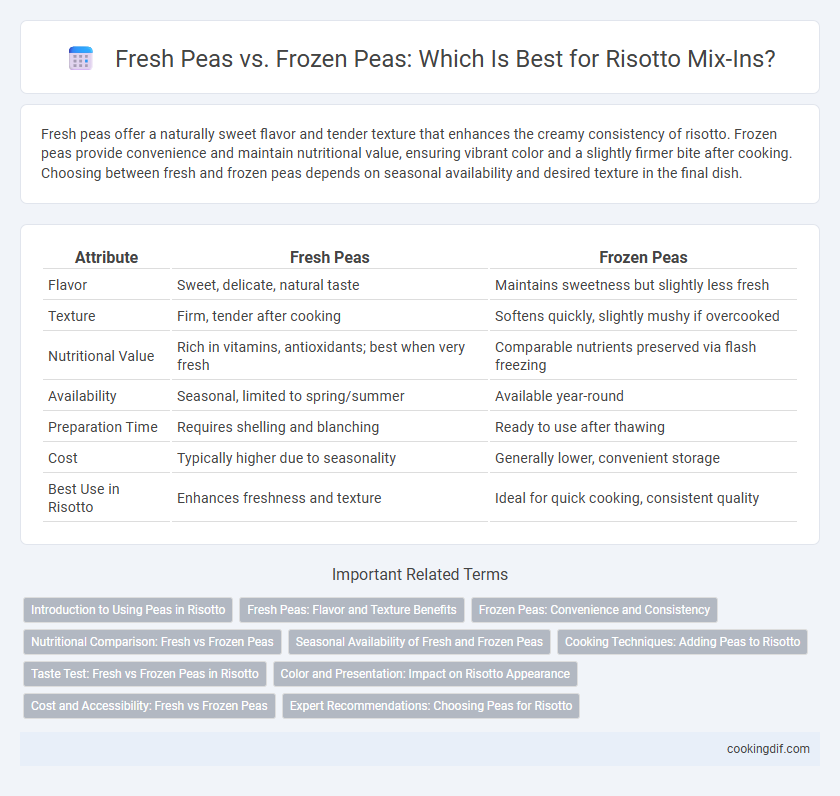Fresh peas offer a naturally sweet flavor and tender texture that enhances the creamy consistency of risotto. Frozen peas provide convenience and maintain nutritional value, ensuring vibrant color and a slightly firmer bite after cooking. Choosing between fresh and frozen peas depends on seasonal availability and desired texture in the final dish.
Table of Comparison
| Attribute | Fresh Peas | Frozen Peas |
|---|---|---|
| Flavor | Sweet, delicate, natural taste | Maintains sweetness but slightly less fresh |
| Texture | Firm, tender after cooking | Softens quickly, slightly mushy if overcooked |
| Nutritional Value | Rich in vitamins, antioxidants; best when very fresh | Comparable nutrients preserved via flash freezing |
| Availability | Seasonal, limited to spring/summer | Available year-round |
| Preparation Time | Requires shelling and blanching | Ready to use after thawing |
| Cost | Typically higher due to seasonality | Generally lower, convenient storage |
| Best Use in Risotto | Enhances freshness and texture | Ideal for quick cooking, consistent quality |
Introduction to Using Peas in Risotto
Fresh peas provide a naturally sweet flavor and tender texture that enhances the creamy consistency of risotto, offering vibrant color and a delicate bite. Frozen peas retain much of their nutritional value and sweetness due to quick-freezing, ensuring convenience without sacrificing taste or quality. Incorporating either type, peas add subtle earthiness and a burst of freshness that complements the rich, savory profile of traditional risotto dishes.
Fresh Peas: Flavor and Texture Benefits
Fresh peas enhance risotto with a naturally sweet, vibrant flavor and a tender yet slightly firm texture that frozen peas often lack. Their delicate freshness intensifies the dish's overall aromatic profile and provides a pleasant contrast to the creamy risotto base. Using fresh peas ensures a superior mouthfeel and brightness that elevates the culinary experience.
Frozen Peas: Convenience and Consistency
Frozen peas provide consistent sweetness and texture in risotto, maintaining quality due to flash-freezing at peak ripeness. Their convenience allows for easy storage and year-round availability, eliminating the need for immediate use unlike fresh peas. Incorporating frozen peas ensures reliable cooking times and flavor balance, enhancing the overall dish with minimal preparation effort.
Nutritional Comparison: Fresh vs Frozen Peas
Fresh peas contain slightly higher levels of vitamin C and antioxidants due to minimal processing, while frozen peas retain most nutrients through rapid freezing methods that preserve vitamins A, K, and folate effectively. Both fresh and frozen peas offer comparable amounts of protein, fiber, and essential minerals such as iron and magnesium. Choosing between fresh and frozen peas for risotto largely depends on seasonal availability and convenience, without significant nutritional compromise.
Seasonal Availability of Fresh and Frozen Peas
Fresh peas offer vibrant flavor and texture when in season from late spring to early summer, making them ideal for risotto during that period. Frozen peas provide a convenient, year-round alternative with reliable sweetness, harvested and flash-frozen at peak freshness to preserve nutrients and taste. Choosing between fresh and frozen peas depends on the risotto's timing and the desired intensity of pea flavor in the dish.
Cooking Techniques: Adding Peas to Risotto
Fresh peas offer a tender texture and naturally sweet flavor when added at the end of risotto cooking, gently simmered for just a few minutes to preserve their vibrant color and crunch. Frozen peas provide convenience and consistent sweetness, best stirred into the risotto during the final minutes of cooking to thaw quickly without losing their firmness. Incorporating peas gradually while gradually adding broth ensures even cooking and a harmonious blend of creamy risotto with perfectly cooked peas.
Taste Test: Fresh vs Frozen Peas in Risotto
Fresh peas deliver a sweeter, more vibrant flavor and tender texture that enhances the creamy richness of risotto, while frozen peas offer convenience and a consistent, slightly milder taste with a firmer bite. Taste tests reveal that fresh peas provide a subtle sweetness and fresh vegetal notes, elevating the overall dish, whereas frozen peas maintain a good balance of flavor and texture but may lack the delicate nuances of fresh produce. Comparing both options, fresh peas remain the preferred choice for gourmet-quality risotto, especially when peak season freshness is available.
Color and Presentation: Impact on Risotto Appearance
Fresh peas enhance risotto with vibrant green hues and a crisp texture, elevating the dish's visual appeal and freshness perception. Frozen peas often appear duller and slightly mushy after cooking, which can diminish the overall presentation and color contrast in the risotto. Choosing fresh peas ensures a brighter, more appetizing appearance, crucial for gourmet-style plating and enticing presentation.
Cost and Accessibility: Fresh vs Frozen Peas
Frozen peas offer a cost-effective and accessible option for risotto mix-ins, maintaining consistent quality and sweetness year-round. Fresh peas, while often perceived as superior in flavor, tend to be more expensive and seasonal, limiting availability outside peak harvest times. Choosing frozen peas ensures convenience and affordability without sacrificing the vibrant color and texture essential for a flavorful risotto.
Expert Recommendations: Choosing Peas for Risotto
Experts recommend fresh peas for risotto due to their sweeter flavor and tender texture, which enhance the dish's creaminess and balance. Frozen peas offer convenience and consistent quality year-round but may result in a slightly less vibrant taste and softer bite. For optimal risotto, use fresh peas in season or high-quality frozen peas blanched briefly to preserve firmness and color.
Fresh peas vs Frozen peas for mix-ins Infographic

 cookingdif.com
cookingdif.com